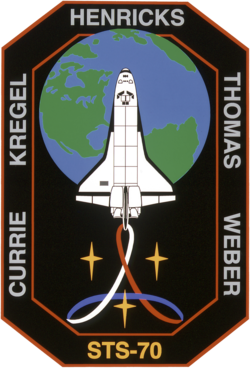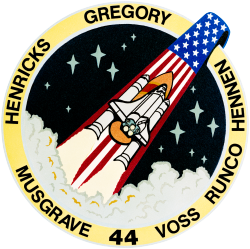Terence T. Henricks
| Terence Thomas "Tom" Henricks | |
 | |
| NASA Astronaut | |
|---|---|
| Född | 5 juli 1952 Bryan, Ohio |
| Tid i rymden | 42 dygn, 18 timmar, 38 minuter |
| Urvalsgrupp | Astronautgrupp 11 |
| Uppdrag | STS‑44, STS‑55, STS‑70, STS‑78 |
| Uppdragsemblem | |
Terence T. Henricks, född 5 juli 1952 i Bryan, Ohio, är en amerikansk astronaut uttagen i astronautgrupp 11 den 4 juni 1985. Henricks gick i skola i Woodmore High School i Woodville, Ohio. Han avlade 1974 sin kandidatexamen vid United States Air Force Academy och 1982 sin master vid Golden Gate University.
Rymdfärder
Källor
- ”Biographical Data” (på engelska) (PDF). NASA. januari 2000. https://www.nasa.gov/wp-content/uploads/2016/01/henricks_terence.pdf?emrc=7caf84. Läst 5 maj 2024.
- Spacefacts
Media som används på denna webbplats
The STS-78 patch links past with present to tell the story of its mission and science through a design imbued with the strength and vitality of the 2-dimensional art of North America's northwest coast Indians. Central to the design is the space Shuttle whose bold lines and curves evoke the Indian image for the eagle, a native American symbol of power and prestige as well as the national symbol of the United States. The wings of the Shuttle suggest the wings of the eagle whose feathers, indicative of peace and friendship in Indian tradition, are captured by the U forms, a characteristic feature of Northwest coast Indian art. The nose of the Shuttle is the strong downward curve of the eagle's beak, and the Shuttle's forward windows, the eagle's eyes, represented through the tapered S forms again typical of this Indian art form.
The basic black and red atoms orbiting the mission number recall the original NASA emblem while beneath, utilizing Indian ovoid forms, the major mission scientific experiment package LMS (Life and Materials Sciences) housed in the Shuttle's cargo bay is depicted in a manner reminiscent of totem-pole art. This image of a bird poised for flight, so common to Indian art, is counterpointed by an equally familiar Tsimshian Indian symbol, a pulsating sun with long hyperbolic rays, the symbol of life. Within each of these rays are now encased crystals, the products of this mission's 3 major, high-temperature materials processing furnaces. And as the sky in Indian lore is a lovely open country, home of the Sun Chief and accessible to travelers through a hole in the western horizon, so too, space is a vast and beckoning landscape for explorers launched beyond the horizon.
Beneath the Tsimshian sun, the colors of the earth limb are appropriately enclosed by a red border representing life to the Northwest coast Indians. The Indian colors of red, navy blue, white, and black pervade the STS-78 path. To the right of the Shuttle-eagle, the constellation Delphinus recalls the dolphin, friend of ancient sailors and, now perhaps too, of the 9 space voyagers suggested by this constellation's blaze of 9 stars. The patch simultaneously celebrates international unity fostered by the Olympic spirit of sports competition at the 1996 Olympic Games in Atlanta, Georgia, U.S.A. Deliberately poised over the city of Atlanta, the Space Shuttle glows at its base with the 5 official Olympic rings in the 5 Olympic colors which can also be found throughout the patch, rings and colors which signify the 5 continents of the earth. This is an international mission and for the first time in NASA patch history, astronauts have dispensed with identifying country flags beneath their names to celebrate the spirit of international unity so characteristic of this flight.STS-70 Mission Insignia
The STS-70 crew patch depicts the Space Shuttle Discovery orbiting Earth in the vast blackness of space. The primary mission of deploying a NASA Tracking and Data Relay Satellite (TDRS) is depicted by three gold stars. They represent the triad composed of spacecraft transmitting data to Earth through the TDRS system. The stylized red, white, and blue ribbon represents the American goal of linking space exploration to the advancement of all humankind.
STS-55 Mission Insignia
STS-44 Mission Insignia
portrait astronaut Terence Henricks





